Early August of this year I drove from my home in NW Connecticut to Nakina, Ontario, a small town in northwestern Ontario, pretty much the end of the road. A friend from that area, Memaquay here at this site, had told me of a canoe route he thought I might enjoy, it offered great scenery, equally good fishing, wildlife viewing and solitude. He turned out to be right on all counts.
I arrived at the parking lot for Marshall Lake, my starting point for my canoe trip by noon and had the gear and canoe unloaded and ready to go in short order.
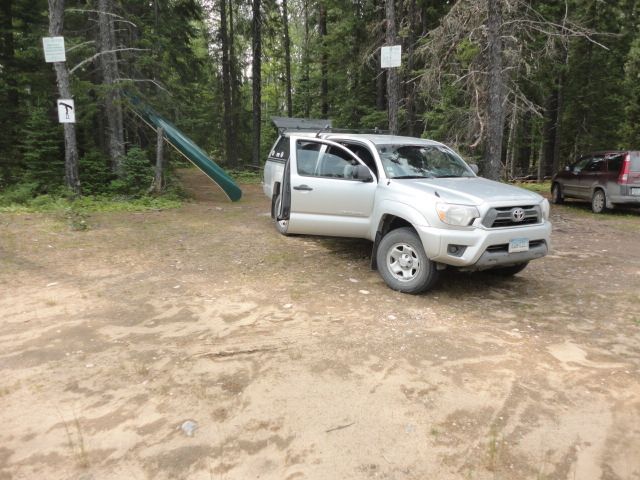
There is a nice road that leads the 1200 meters from the parking area right down to the lake but no public motor vehicles are allowed to use it. I had to make two trips and it took me an hour. I carry two Duluth Packs, one is a day pack with my food, the other is a #4 Wanderer with my clothes and gear, two beavertail paddles and two fishing rods with a very small tackle bag.
The put in on Marshall Lake
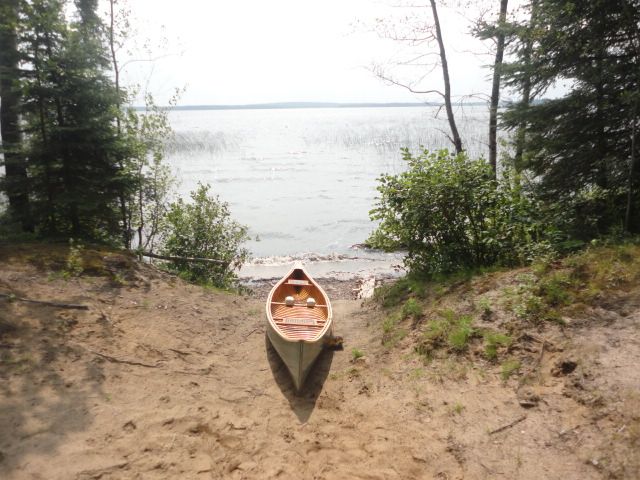
The wind was blowing onshore and I had to hug the shoerline to make any headway. By late afternoon I arrived at one of the few campsites on the lake, Dog Island. I made a comfortable camp under my tarp just before the heavens opened up and the rains came. I ate a quick dinner and was in bed before dark, tired from the long ride and excitement.
First camp
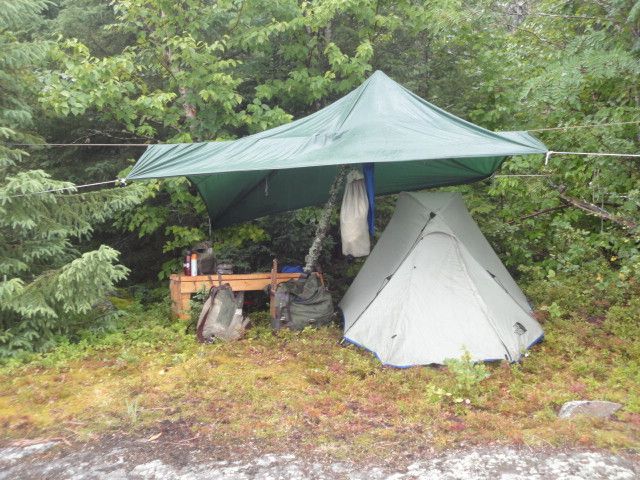
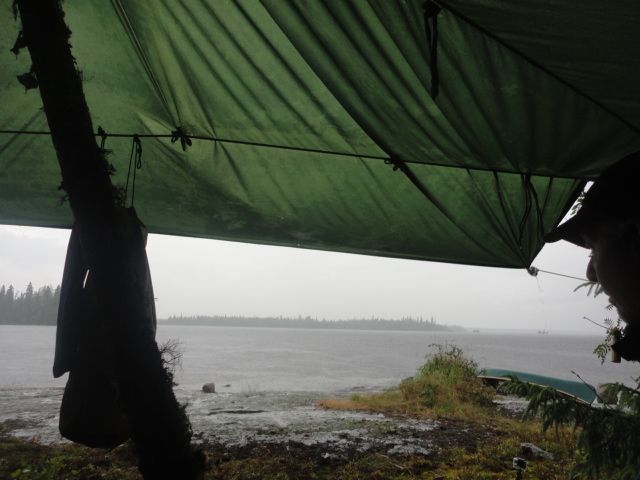
The sky had cleared by morning and I enjoyed a nice breakfast of pancakes and coffee cooked over my "littlbug" twig stove. As long as there is no fire ban or threats of one, I leave my heavy stove and fuel home nowadays and use just the Littlbug. It uses twigs burned in a collapsible SS cylinder. It burns hot, great for boiling water but there is a learning curve for slow cooking. It weighs next to nothing and uses zero space when collapsed.
Leaving Dog Island, 15' Chestnut Chum wood canvas,
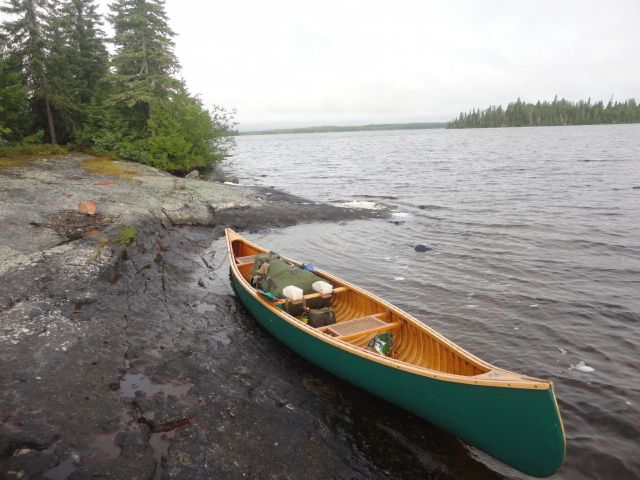
I left Marshall lake and entered the Grip River which flows into Gripp lake. I would make 3 portages before I entered Gripp Lake, the first at an old trappers cabin. It was interesting examining the living quarters and wondering what life was like for the person who lived there during the trapping seasons.

The portages on the Gripp where pretty much overgrown with brush and I had trouble finding the 3rd takeout. I had good details as to where each port started, but the sighs and flagging had long since gone and I spent some time bushwhacking through the wet grass and alders. Since these trails have been used for hundreds if not more years, there is almost always a worn path in the dirt, or old cuttings, just finding it when the brush is overgrown can be a problem. I finally did find my way and paddled down to beautiful Gripp Lake.
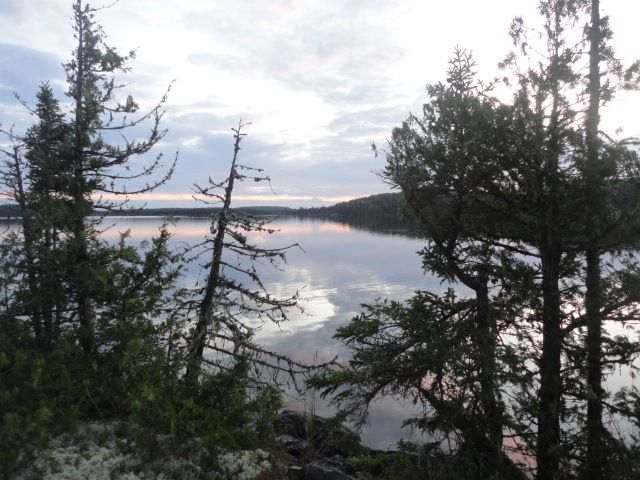
Gripp Lake has many rock outcrops surrounded by caribou moss giving it a park like atmosphere. Being solo, I picked a really pretty point that could only fit one tent on some level moss. I wasn't planning a fire, just my little stove so a large flat rock was my kitchen area right out by the lake. What a view. It's been a long day, I eat a quick dinner of fresh caught pickerel and I'm asleep in my tent just as the sun sets.
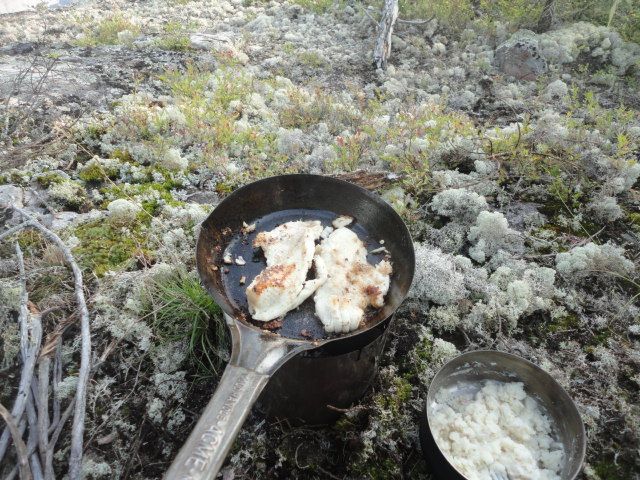
The next morning I ate a breakfast of pancakes and coffee, taking advantage of the nice calm weather,

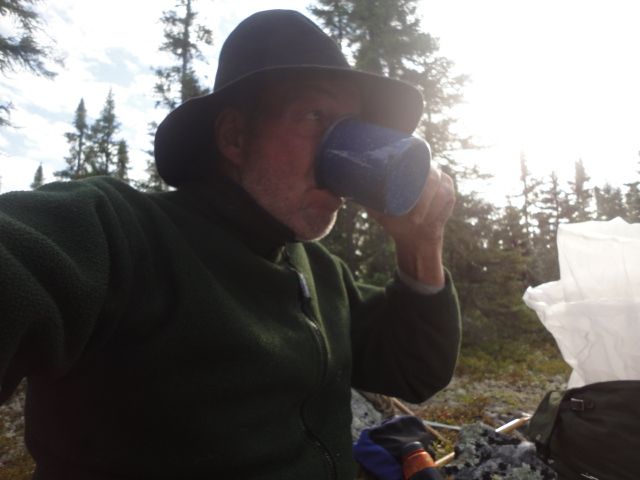
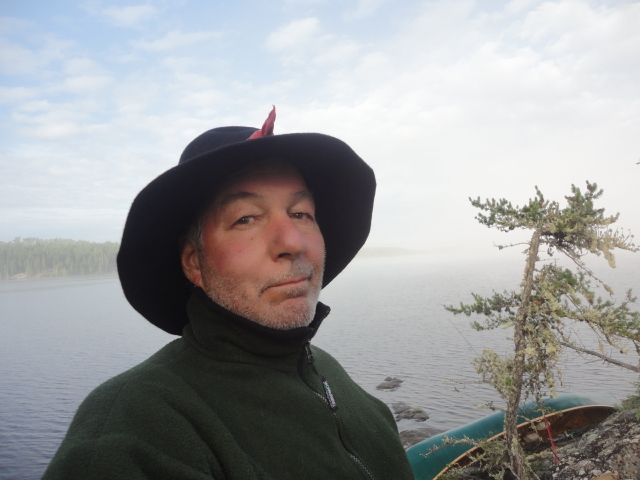
About that hat, bought it for a dollar at a tag sale, works well at either keeping the sun or rain off my face and shoulders. The bandana, well, good for coyote breakfasts, that is, walk down to the lake, drink some water, wash my face and take a good look around.
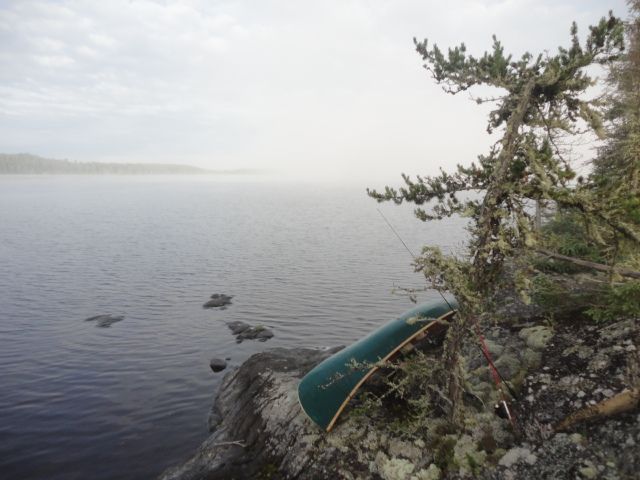
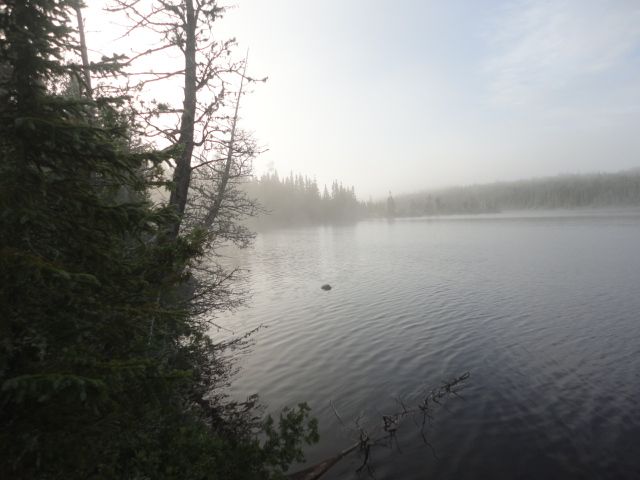
Then I paddled the lake, fishing and observing the beauty. I caught a few pickerel (walleye), releasing all but one. I headed for a large flat outcrop where I found a First Nations campsite,
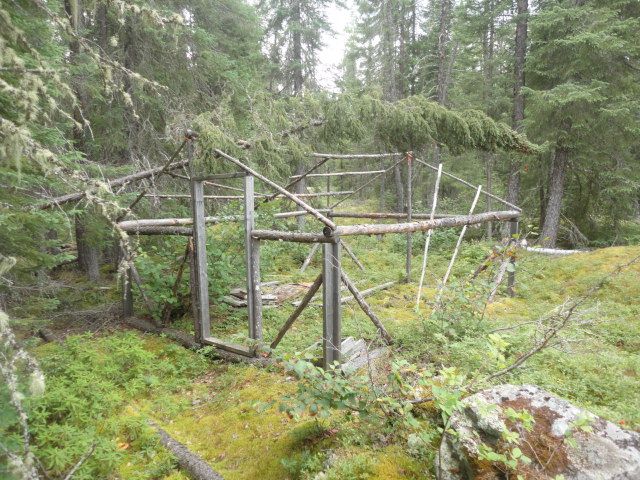
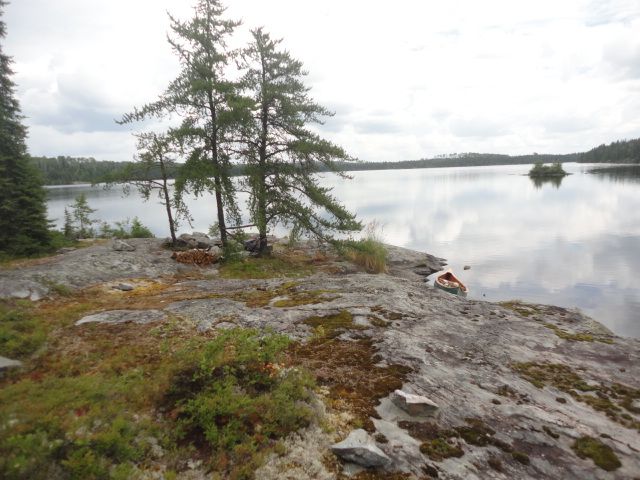
they had left a spruce frame which supports their canvas tents during the fall hunting season, and a nice fire pit with ample firewood. I had brought my cold handle frying pan and coffee pot with me and before long I was frying my fresh caught pickerel over a small fire. I added some instant Idahoan potatoes (instant but very good and so easy to make), and some coffee to finish off a great shore lunch.


I paddle back to the tent and break camp, heading down a long arm of Gripp Lake to a campsite before it's outflow into the Gripp River. This camp is on a high ridge with a wonderful view and plenty of blueberries.
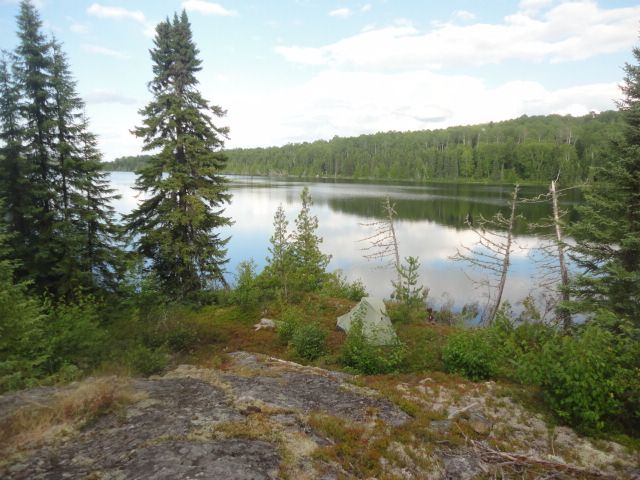
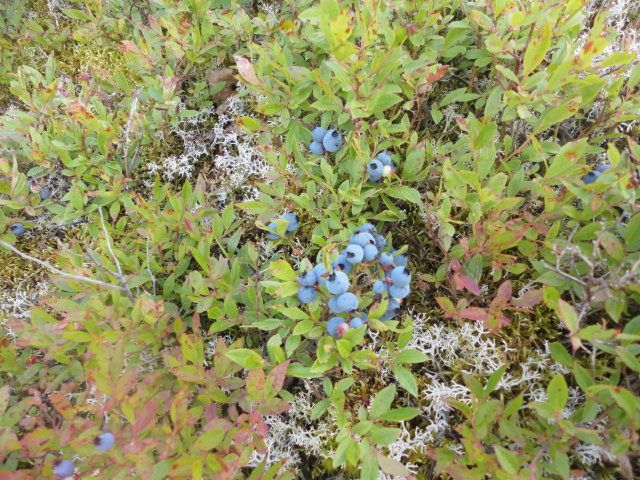
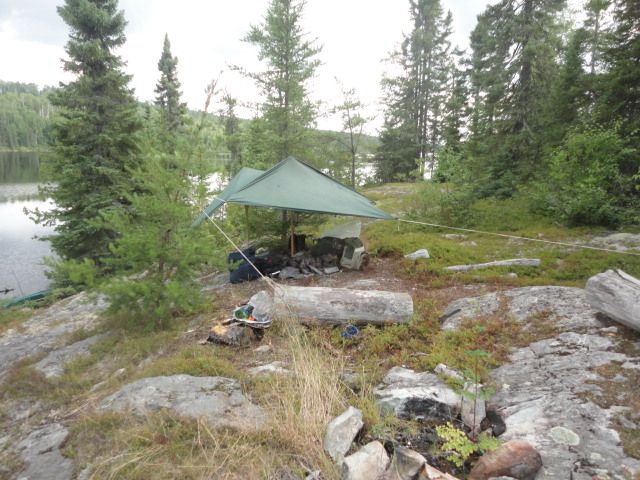
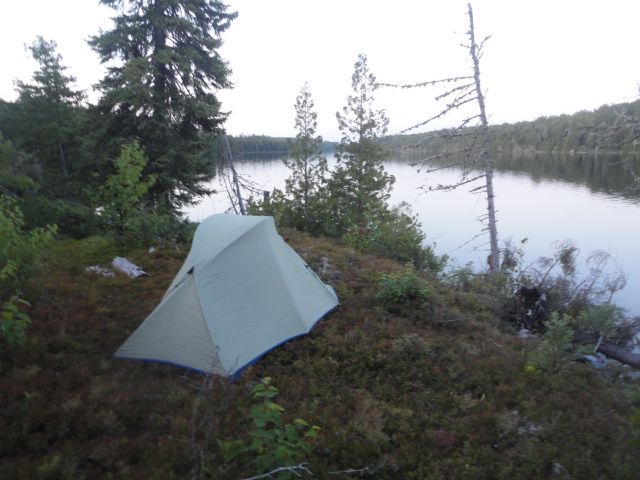
Up to this point I had seen 5 moose, when I spot a cow moose and calf walking the shoreline. She must have saw me and soon they where making their way back into the bush.
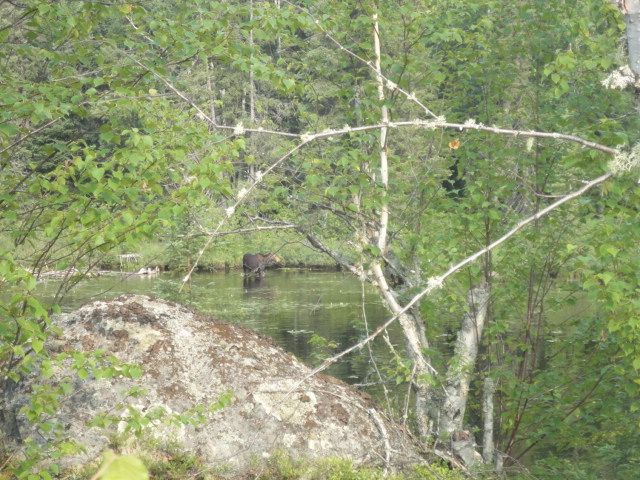
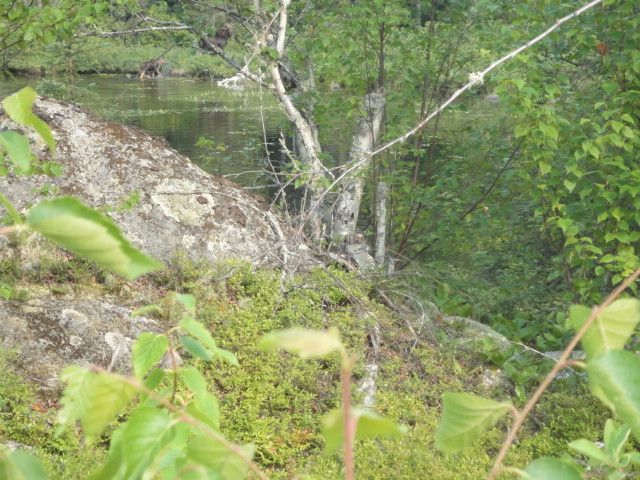
The next morning I enjoy a breakfast of pancakes and blueberries covered in some excellent maple syrup.
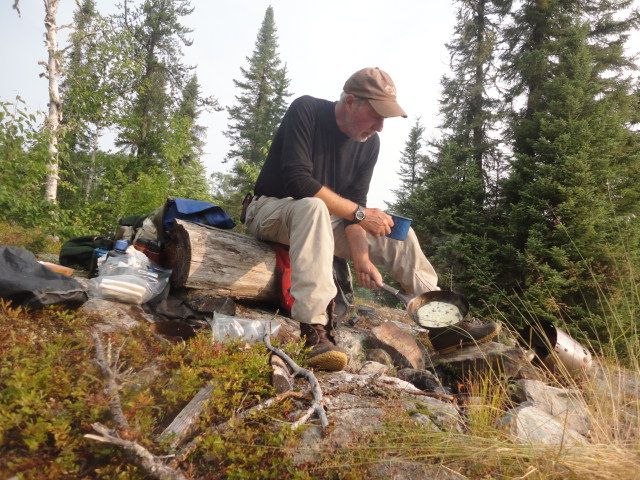
I move down the remainder of Gripp Lake, enter the Gripp River, complete a 290 meter portage and head down the Gripp River for Summit Lake.
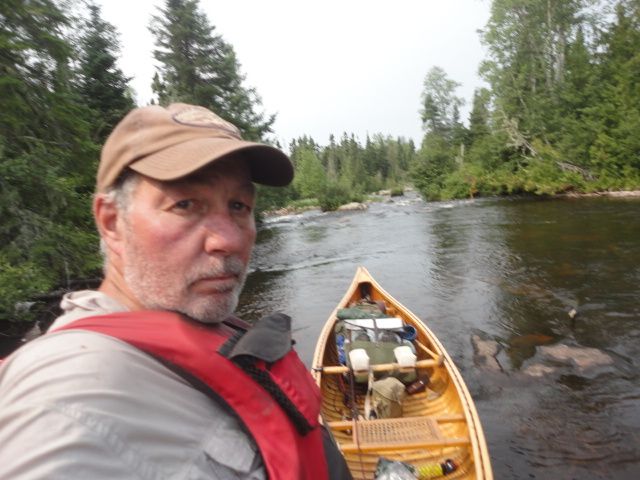
Summit is a height of land lake where the water flowing out of the north ends reaches James Bay, while the water flowing from the south end eventually reaches the Atlantic. It is also shallow and full of wild rice. It was not hard to imagine native people harvesting wild rice in their canoes in this place.
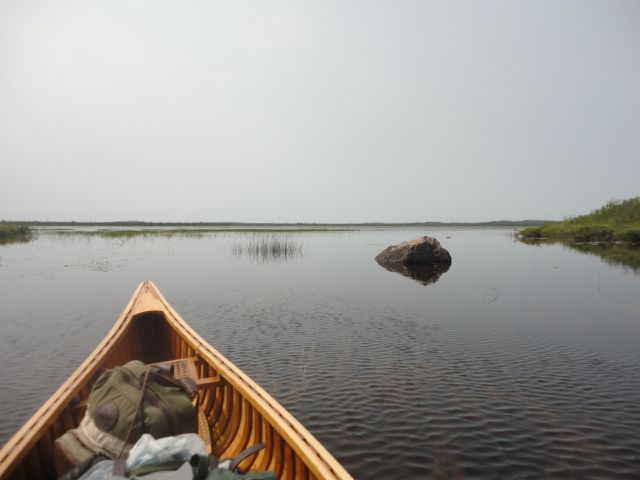

I find a nice campsite along the western side and set up camp. The weather is changing and I have my tarp set up just in case. My preparation paid off, a storm rolled in and I watched it from under my tarp. No sooner had it arrived than it was gone, skys cleared and I went fishing to no avail.

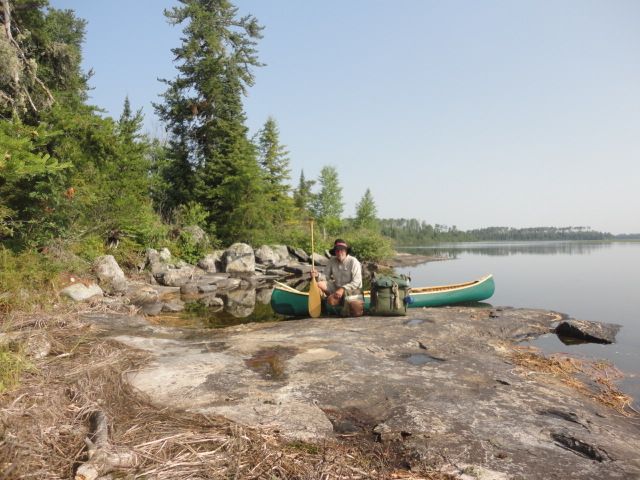
Leaving Summit, I entered the Powtik River and here is where I had my first experience at walking my canoe through some shallow rapids.
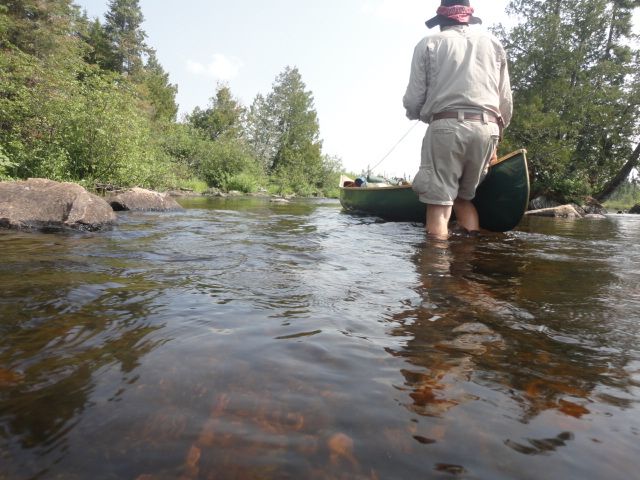

The Powtik is a small narrow river and it was a pleasant paddle. I observed many mother ducks with youngsters, but they usually had only 2-3 ducklings, I believe predation is heavy in this area and a young ducks odds are not good to make it to that first flight.
Eagles, hawks, ravens, crows, seagulls and huge pike all play a part in this I believe. I arrived at a spot in the river where I had 2 sets of rapids, yet the portages where hard to find. I waded one, and found the trail for the second.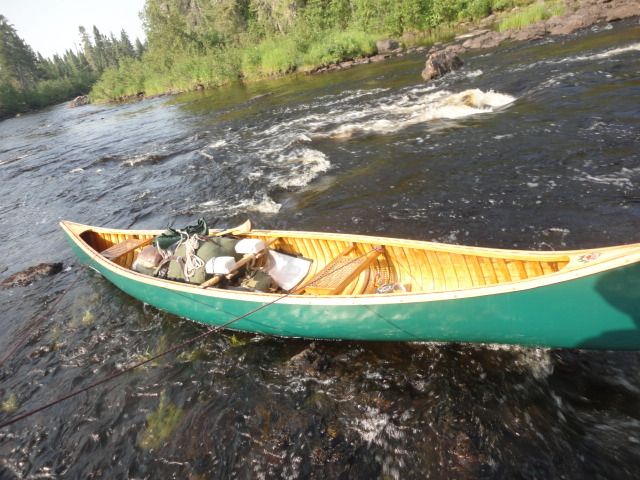

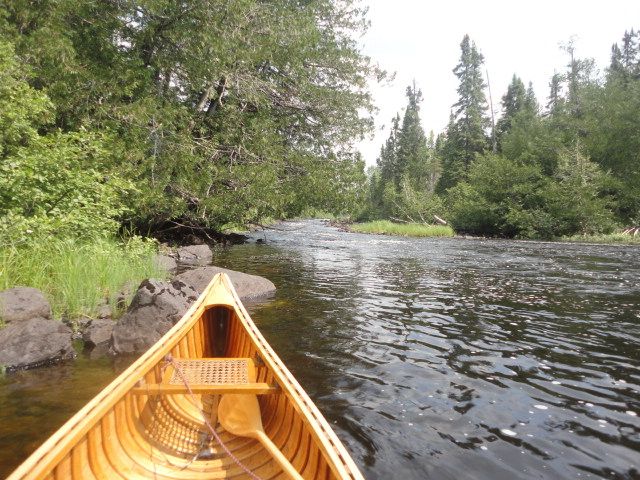
My canoe had a pretty nice paint job before the trip, some light sanding and smoothing and it'll look like new with a fresh coat of green paint this fall.
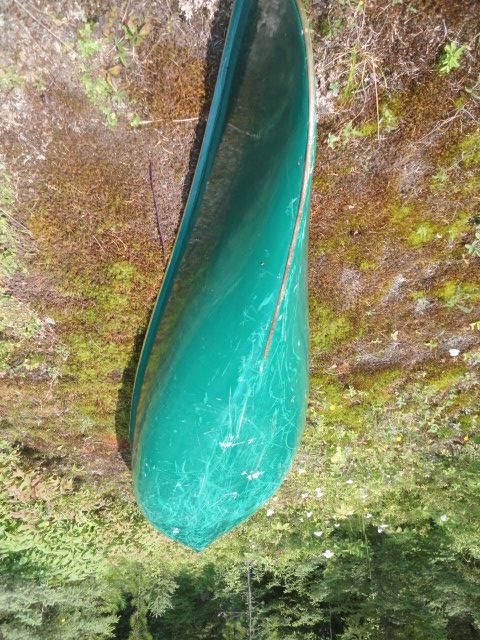
That evening I stayed at a nice campsite, a huge rock face overlooking the river below.
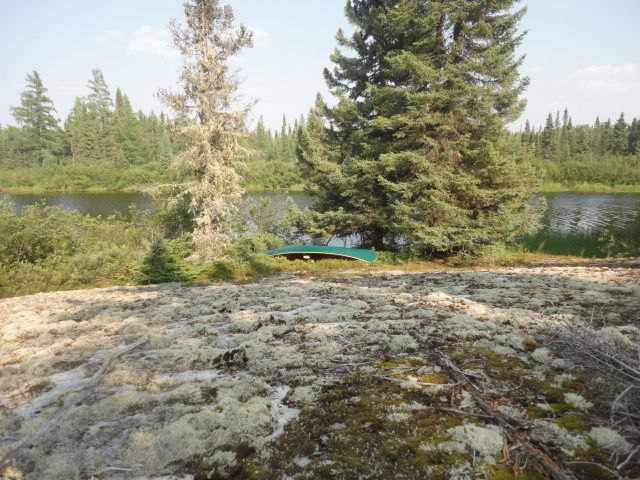
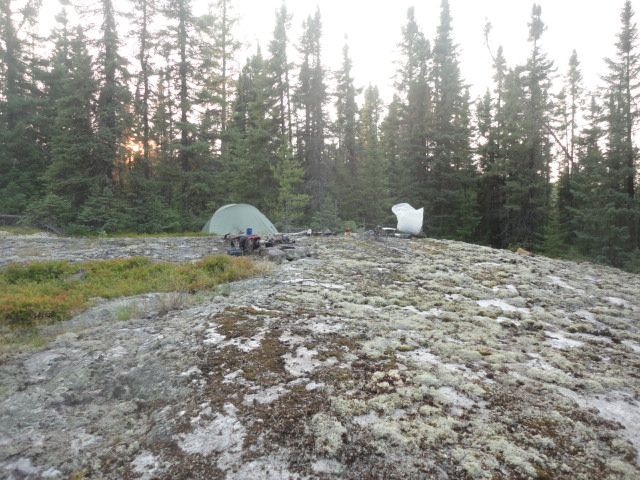
The site was covered in moss and goose poops. That evening I heard a bull moose back in the bush, he was softly coughing or grunting the way they do, so I called out to let it know of my presence. He came back at daybreak, walking the shoreline, he even had a beaver concerned this time as the loud "tail" splash's from the beaver combined with Bullwinkle's splashing/grunts broke the morning stillness. I climbed out of the tent in my bean boots (goose poops between the toes is not funny) and quick drying "black nylon panties" (my wifes term for my tripping underwear) to have a look, not having time to find the camera. I just caught the moose climbing out of the river back into the alders, his rack was big, but his body was massive. One look back at me and he headed for parts unknown. This was the last moose I saw on the trip, which was #8.
More pancakes for breakfast, I'm getting pretty good at maintaining an even fire in the twig stove to cook over (I only show my good results, haha)
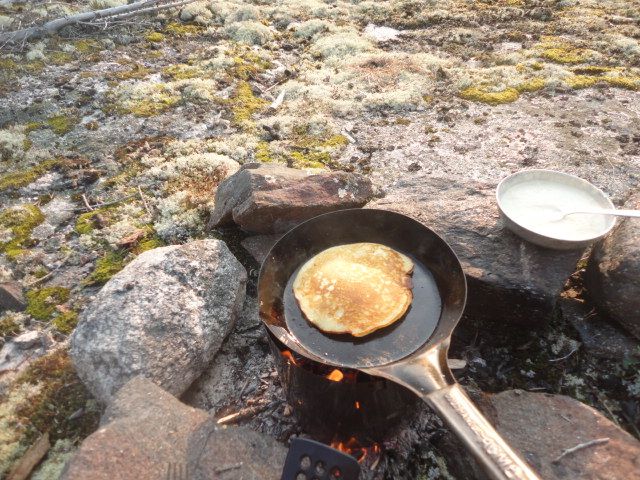
Packed up, I paddled down the Powtik and entered the bigger Kapikotongwa River (the Kap to the locals) It was a long paddle to the next campsite and I was lucky to have absolutely no headwind. The river flows thru some impressive open meadows filled with alders and marshes, landing the canoe was not an option. I encountered 2 bears swimming across the river, these where the 2nd and 3rd of the 4 I saw on the trip. Ducks where numerous but again with very small broods. I wondered if the mother grieved for each loss.
I encountered 3 portages this day and used all 3, about a 1000 meters total.

The Kap at one of the few campsites showing how wide and low the terrain is.
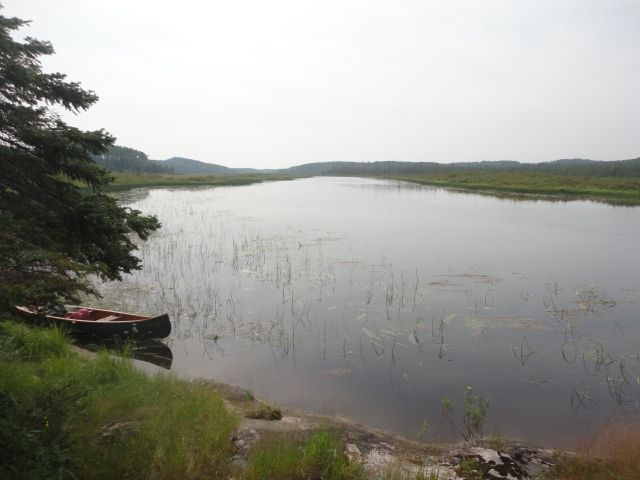
By evening the wind had kicked up and I had to struggle to reach the campsite I planned to stay at. It was a beautiful beach at the end of an esker in a small unnamed lake just off the Kap. The wind blew onshore and the mosquitoes where gone for a change. I was exhausted, no fishing this evening, just a quick Knorr's pasta side and an after dinner nitecap while admiring the beautiful view out front of my site.

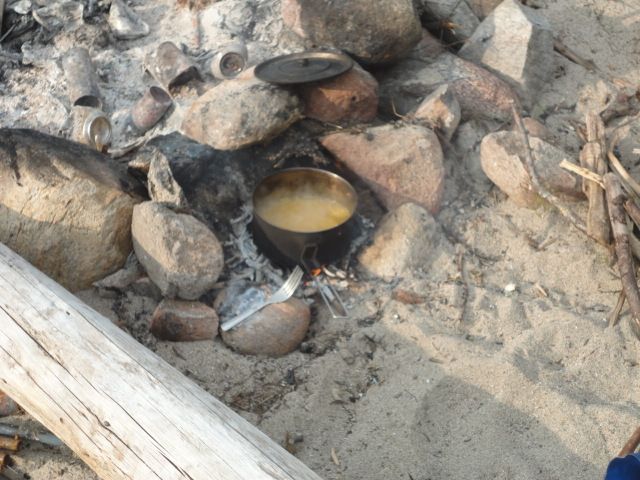
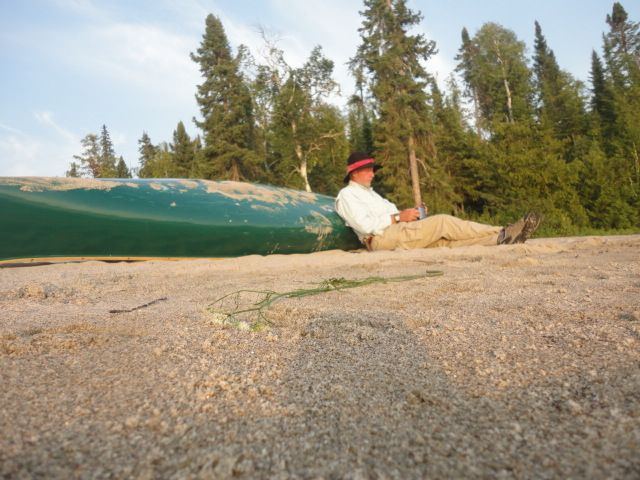
What! Pancakes again?
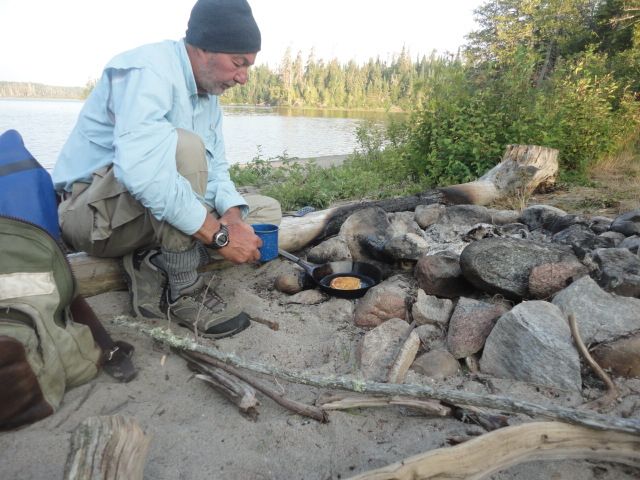
Back to the Kap. This time the wind started early and I spent the rest of the day paddling headwinds. At one point, I entered a small lake where the Kap widened and found a "fly in" fisherman's cabin. I stopped for a stretch and took a minute to see how the other half lives. To be honest, I preferred my little tent, it was dark and musty inside and I could not see myself enjoying any time spent there.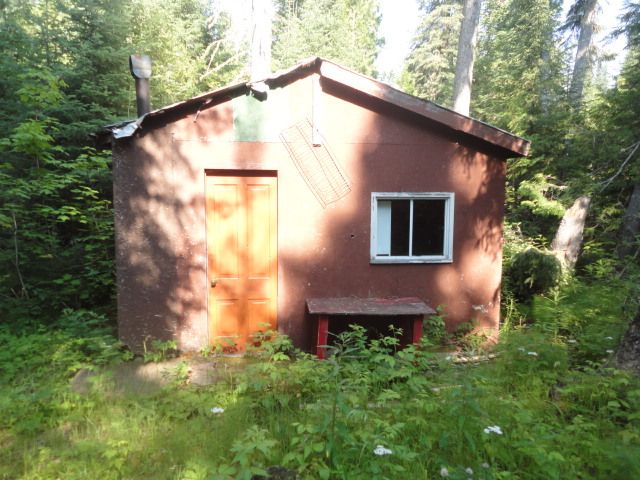
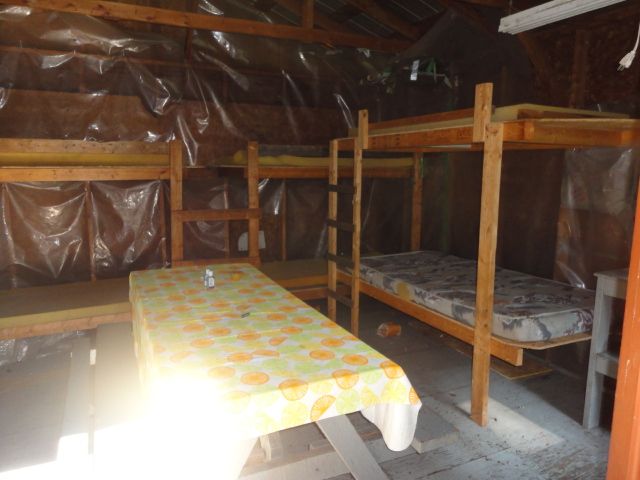
Finally I reached the end of my time on the Kap, it was a difficult part of the trip, but as with any trip you take the good with the bad and I was glad to have had a chance to see the Kap. I also encountered my first people of the trip, having gone 7 days without seeing anyone. A small boat with motor passed me on the Kap headed for Stewart Lake, my destination also.
Stewart is another beautiful lake with many large rock outcrops and one amazing 10' round stone balanced on the edge of a cliff. The wind was blowing so hard that any chance to stop to take pictures would have set me back too far, I fought to round a point where I knew a campsite existed. I stopped for a quick lunch of Idahoian instant patoes and cowboy coffee under a tree out of the sun.
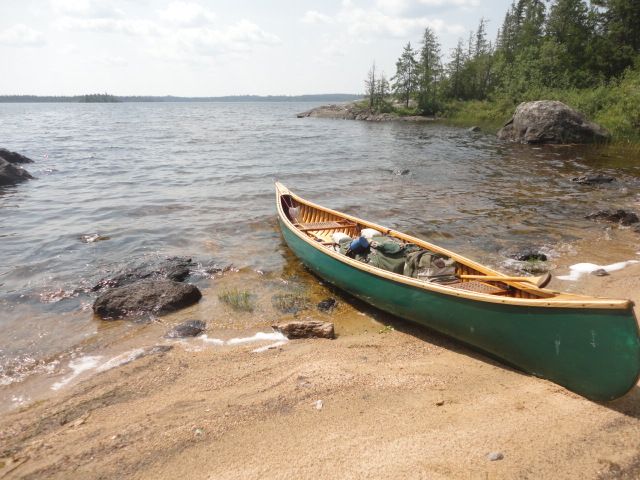
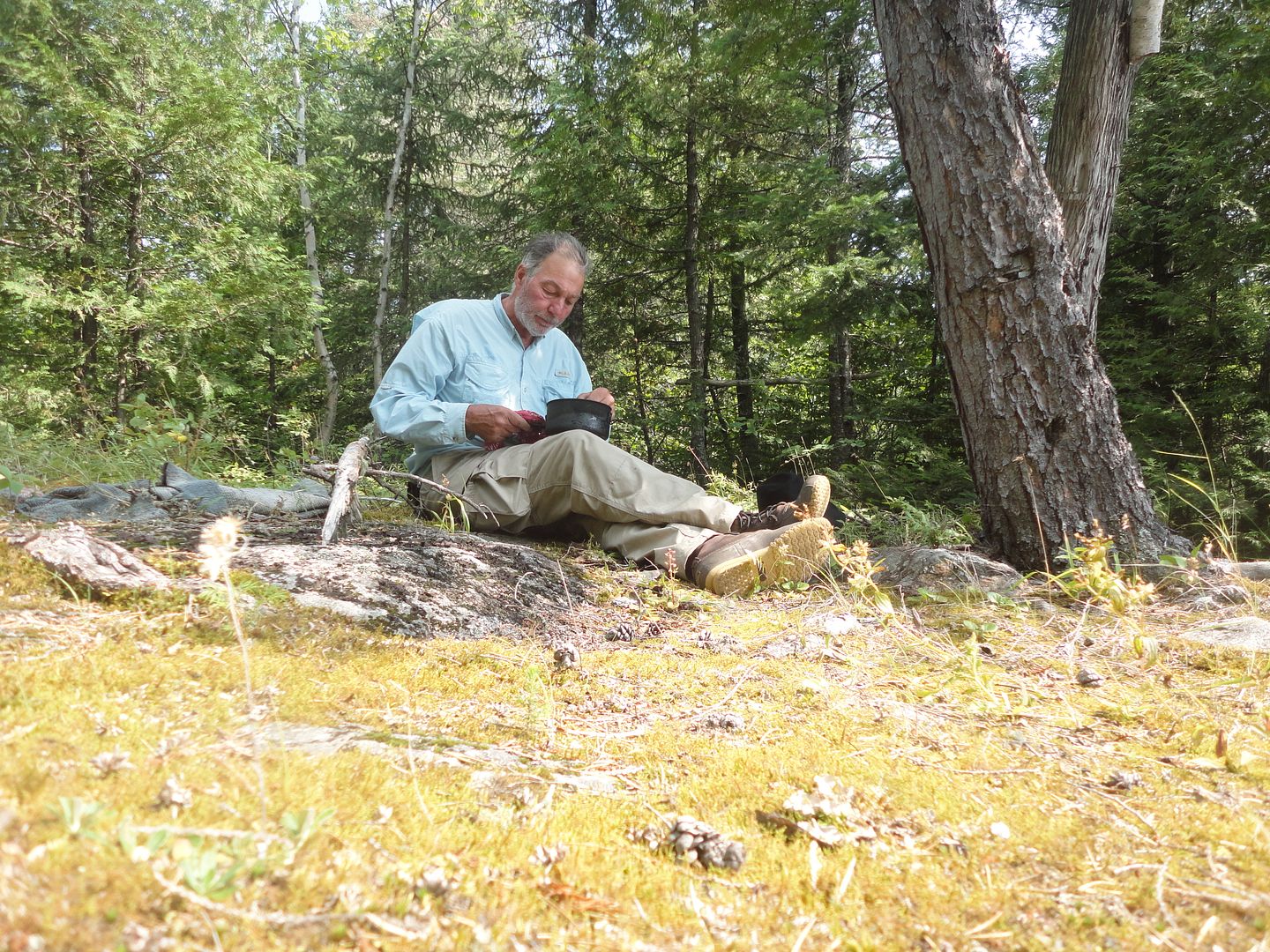
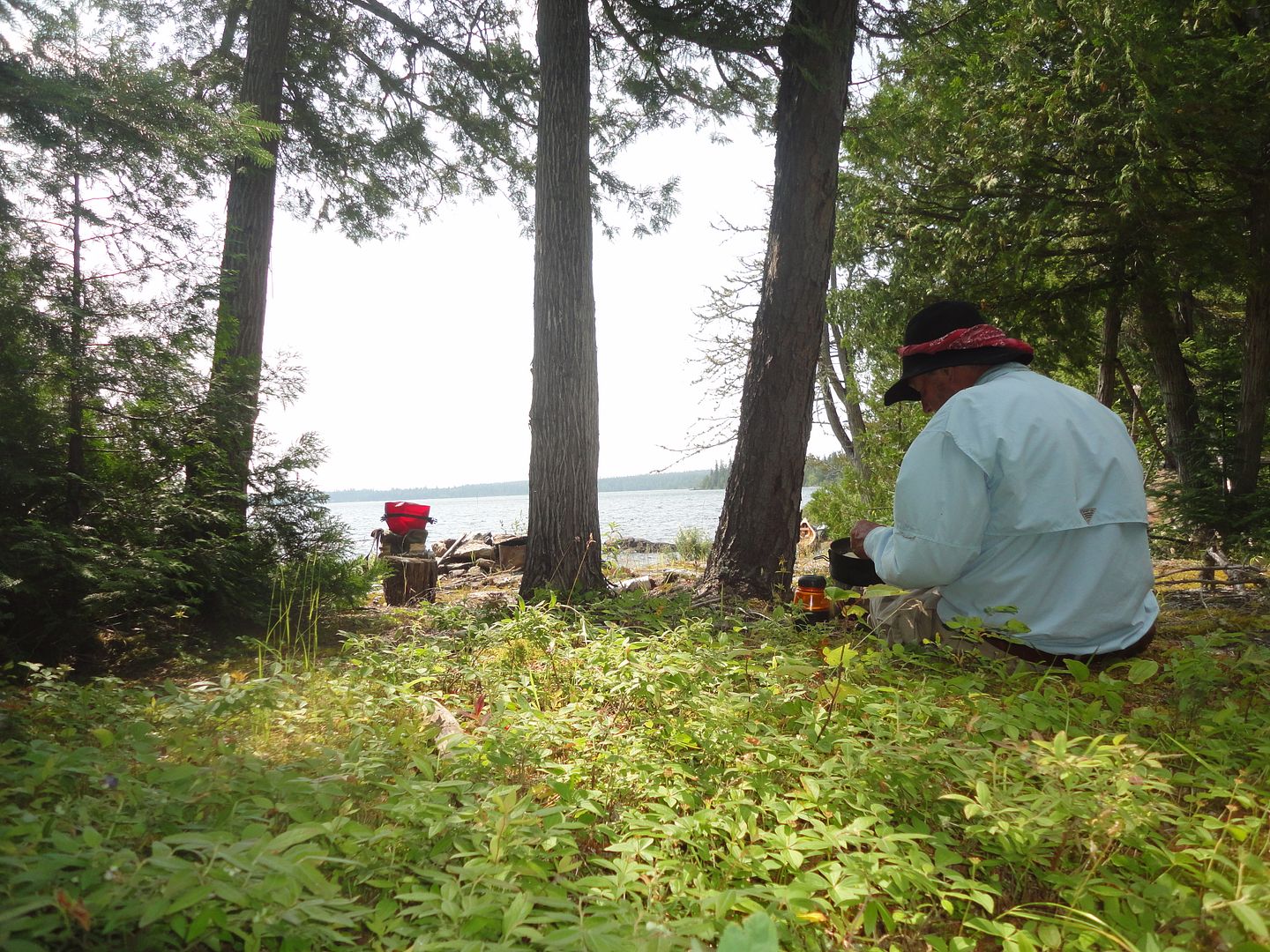
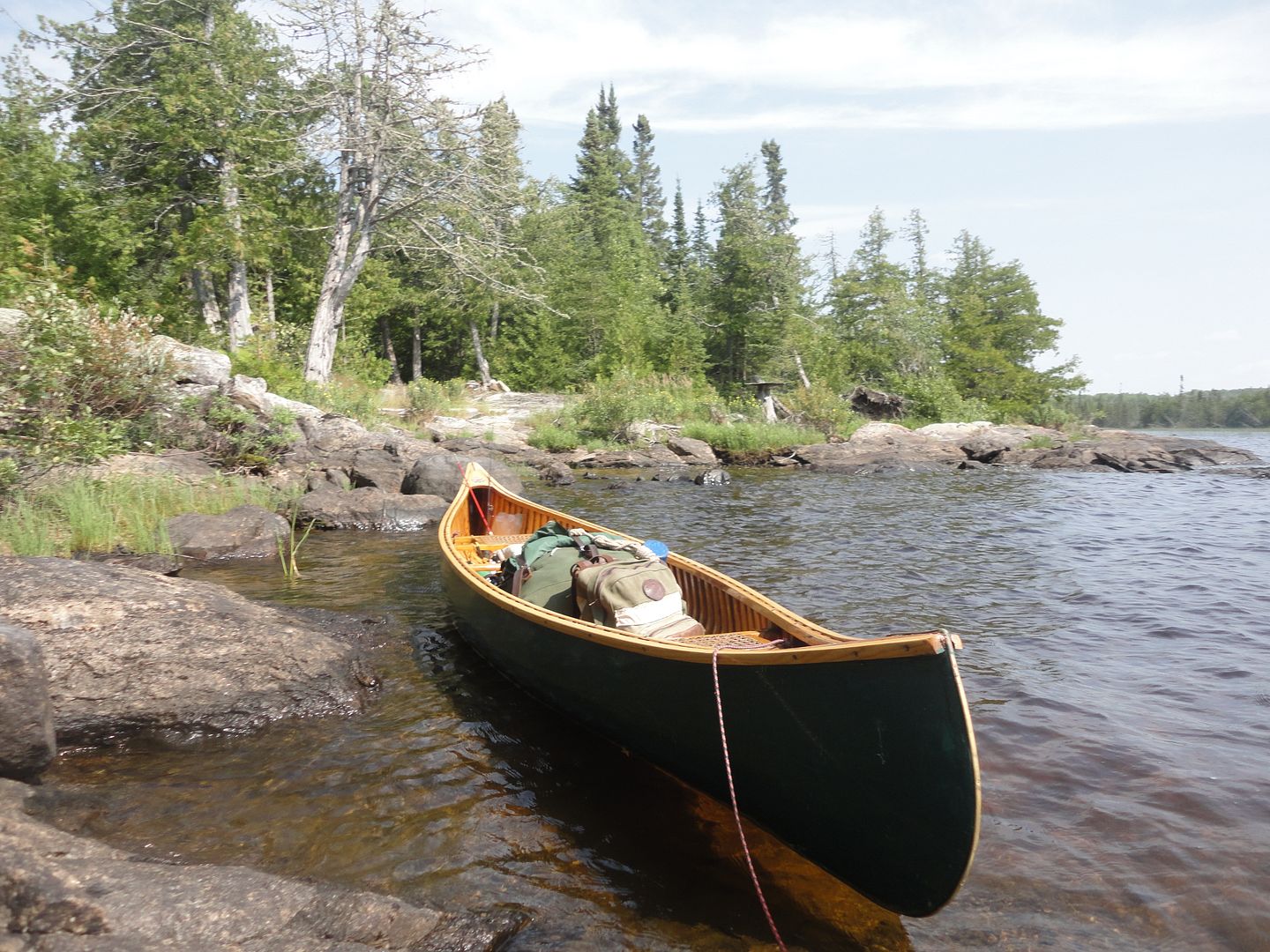
I took a nap and enjoyed my brief stay there.
I pushed on up through Stewart and into Stone Lake.
Portage going upstream into Stone Lake
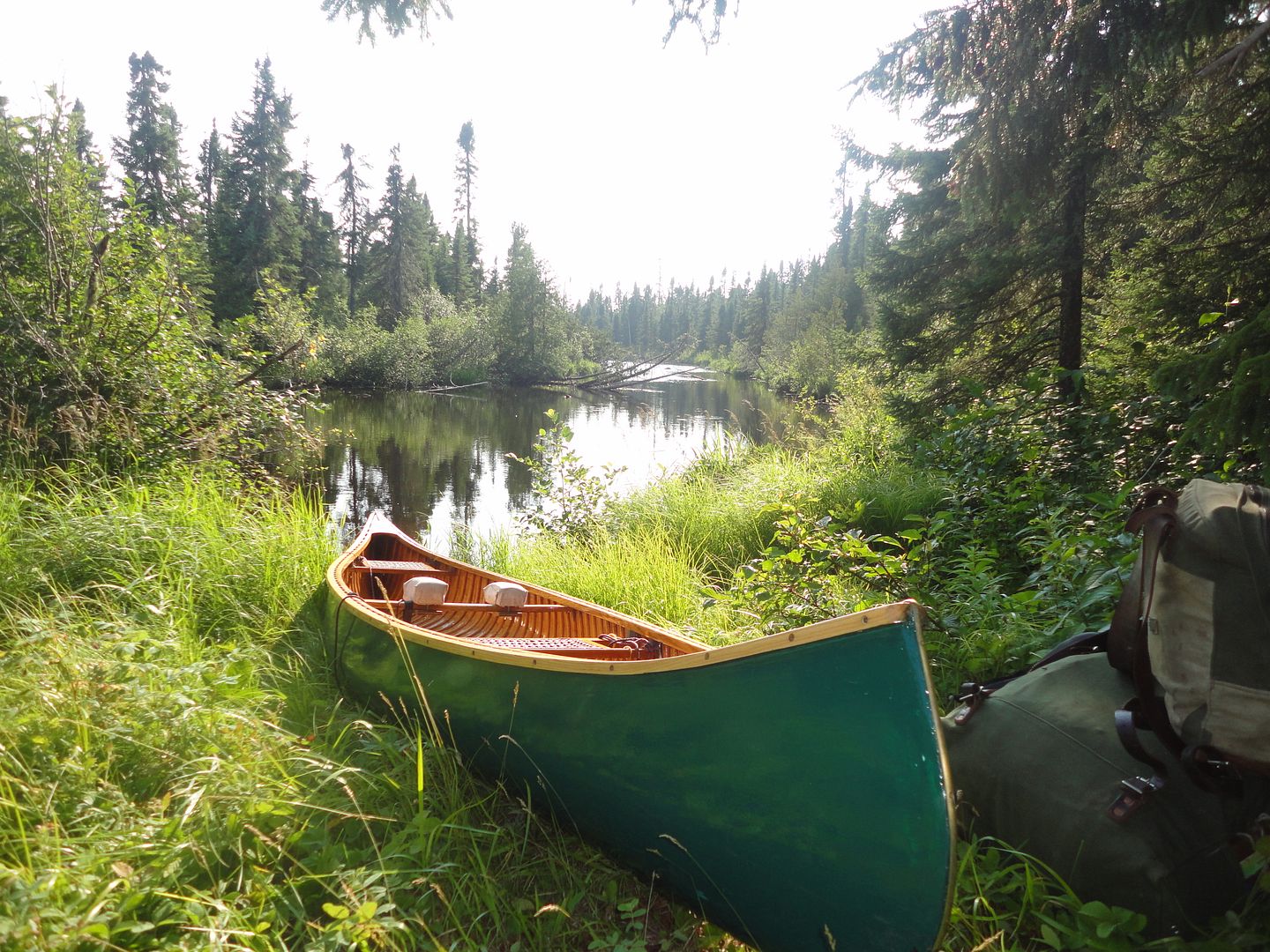
I didn't realize how big stone was viewing my map and with the strong headwind, I was worried that I wouldn't make the one campsite on the lake. The bush grows down to the water here and the only other option would have been to carve a site out back in the bush after a rough landing. I watched as the sun was dropping in the sky and contiued to paddle into the wind, just staying off shore and trying to use ever wind block I could to gain some ground.
Fortunatley, as evening approaches the wind dies down as a rule, and tonight was no different. By the time I reached my campsite I was paddling on near glass. Again, it was a large rock outcrop and it made a really nice open site. A few casts into the lake and I had a pickerel for dinner. Again, another nitecap while looking out over a beautiful Canadian lake, I counted my blessings once more.
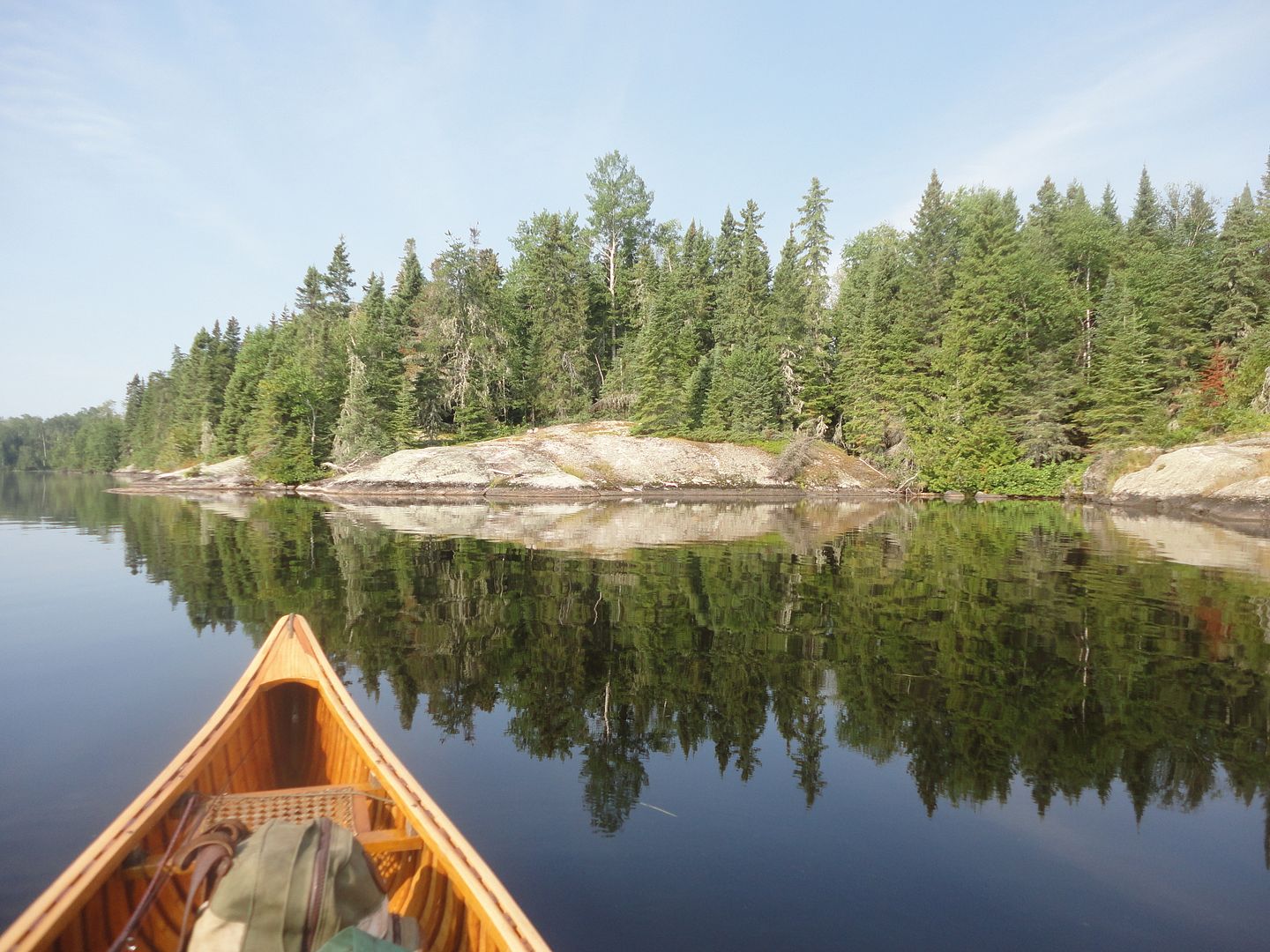


The following morning I got a quick start as I had a mile long portage that had some wet areas and who knows about the blowdowns. I did this port in 2 trips, first with my two packs, paddles, small fishing gear bag and 2 fishing poles. Back for the canoe and not much chance for a sit down as the mosquitoes where pretty bad. The last 50' of this portage was muck and I ended up dragging the canoe by the painter while I clung to saplings jumping from dry spot to dry spot. I expected a "loon crap" put in, but the water level was high and I avoided the mess of pushing the canoe thru floating muck.
Out onto very large Ara Lake without much of a breeze was a stoke of luck. I made my way down the lake, dipping my cup down and scooping up cool drinks to replace the water I lost over the portage. The water was fresh, cool and tasted wonderful. It's a real pleasure to be able to drink directly from a northern lake, just be mindful of the amount of beaver activity along the shore or the beaver fever (giardia) might pay you a visit shortly after your trip.
That evening I camped on a point on Ara Lake, probably the least pleasant site of the trip.
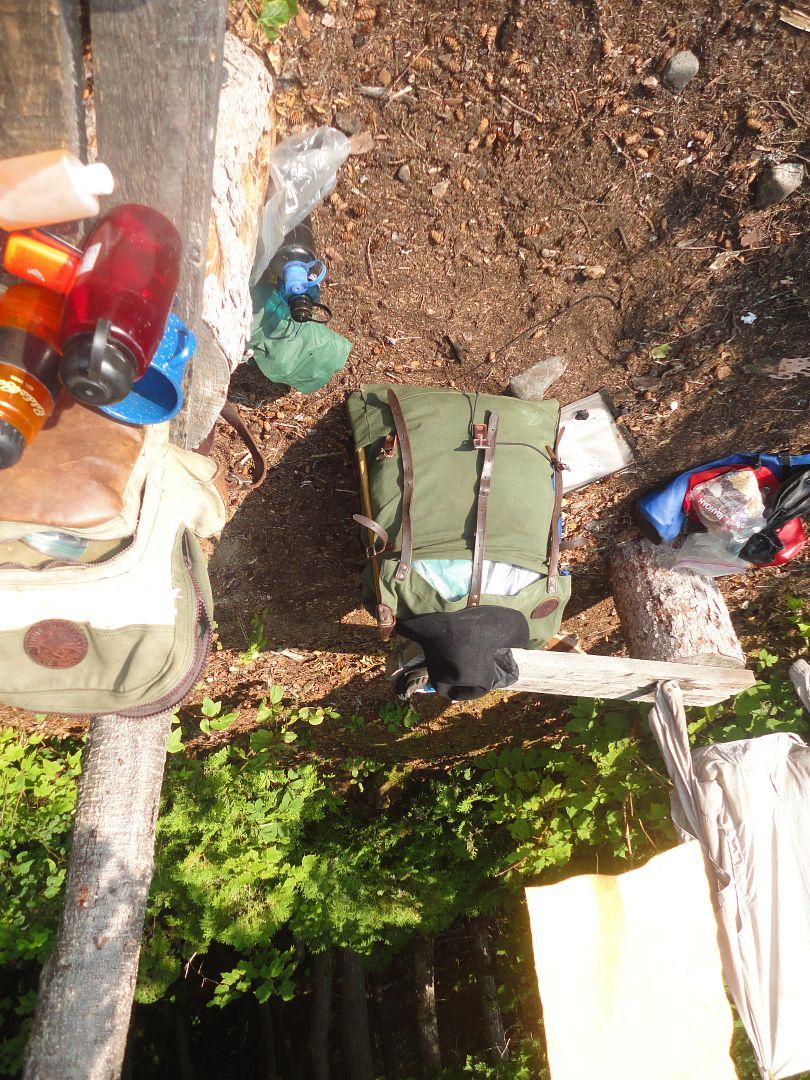
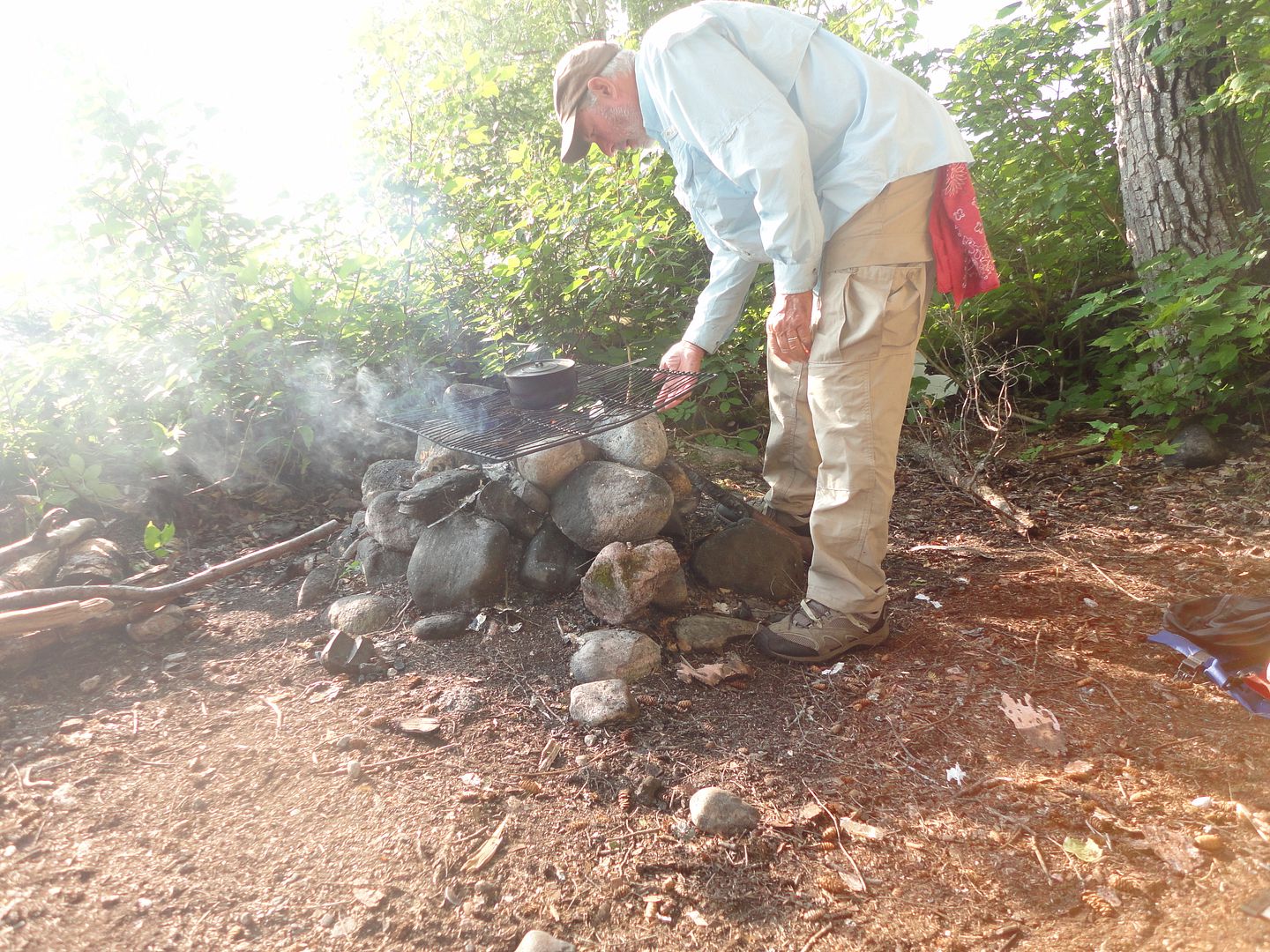
I enjoyed a nice dinner, but the trip was winding down and thoughts of home seemed to linger, thinking of my wife, my dogs, my chainsaw, (not in that order...haha), putting a damper on the evening. As luck would have it, a wind picked up overnight and it appeared I might have to spend another night here. I had to make a crossing of the lake which was a mile wide here and I wasn't willing to take a chance. I waited till about 11 am when the wind began to die down, so I loaded the packs into the canoe and made the crossing. It was a nail biter out in the middle, the wind was stronger and the waves bigger, but I knelled down and remained focused and all went well.
That night my final campsite of the trip was near my final portage of the trip, a 1 and 1/4 mile hike through the bush to my truck. The campsite was nice, although it had a bear bait station set up in the bush behind it. Before setting up my tent, I check the barrel to see if it was active, but cobwebs across the opening proved otherwise.
Another storm came in and I hunkered down under the tarp, knowing all this rain would make for a wet portage the next morning.
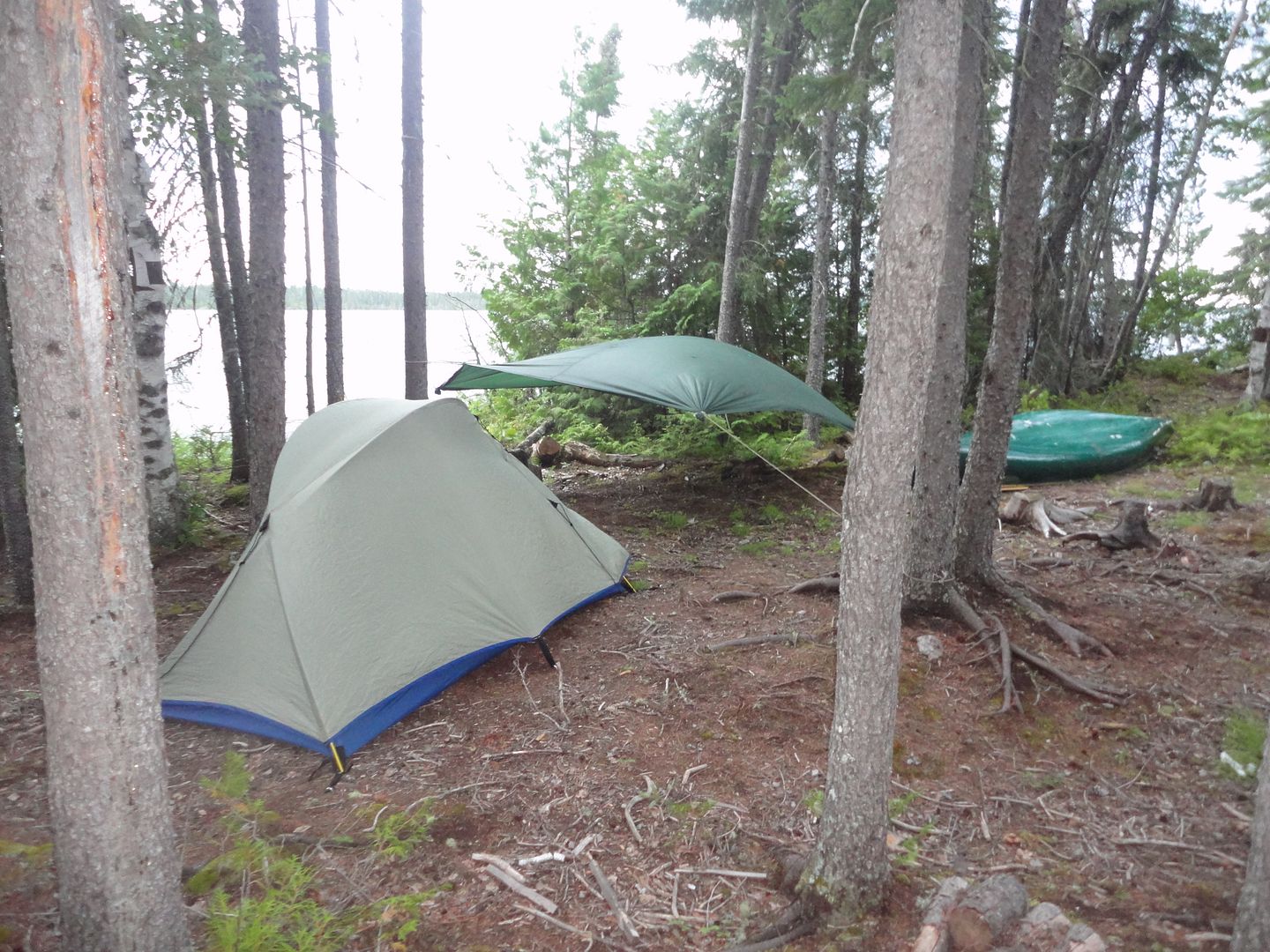
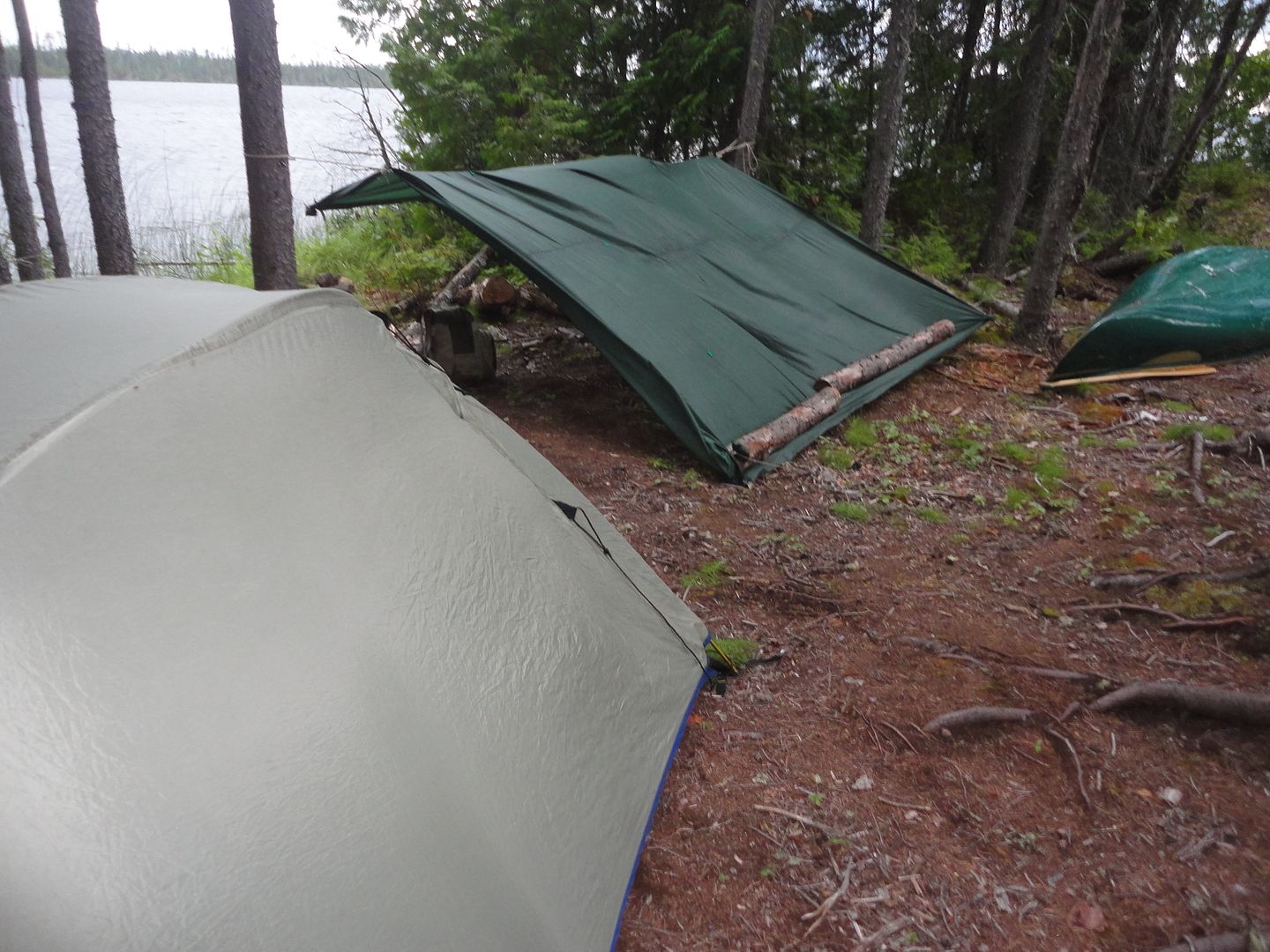
I broke camp and arrived at the portage by almost 10 am.

I predicted a 1pm finish just for kicks. I took out my SPOT device and pressed the all ok button,

sending a message to my wife and others of my location and that I'm ok, then started off with the packs.
I encountered 3 wet spots with mud to the knees, but all in all it was just a long walk in the bush with an occasional blow down. Back for the canoe, clearing the trail as well as possible, I managed to complete the two trips by minutes after 1 pm. I had a warm beer left in the back of the truck and popped it to celebrate the end of a arduous but enjoyable trip, 100 miles of river and lake travel in my canoe.

I ended up seeing 4 bears, 8 moose, countless eagles, 2 pelicans, a swan by itself, tons of ducks, a dozen otters and a fresh wolverine track on a portage.
Thanks to Rob Haslam (Memaquay here on Canoetripping) and his wonderful wife Irene for helping make this trip possible. His advice, encouragement and expertise where invaluable.
I arrived at the parking lot for Marshall Lake, my starting point for my canoe trip by noon and had the gear and canoe unloaded and ready to go in short order.

There is a nice road that leads the 1200 meters from the parking area right down to the lake but no public motor vehicles are allowed to use it. I had to make two trips and it took me an hour. I carry two Duluth Packs, one is a day pack with my food, the other is a #4 Wanderer with my clothes and gear, two beavertail paddles and two fishing rods with a very small tackle bag.
The put in on Marshall Lake

The wind was blowing onshore and I had to hug the shoerline to make any headway. By late afternoon I arrived at one of the few campsites on the lake, Dog Island. I made a comfortable camp under my tarp just before the heavens opened up and the rains came. I ate a quick dinner and was in bed before dark, tired from the long ride and excitement.
First camp


The sky had cleared by morning and I enjoyed a nice breakfast of pancakes and coffee cooked over my "littlbug" twig stove. As long as there is no fire ban or threats of one, I leave my heavy stove and fuel home nowadays and use just the Littlbug. It uses twigs burned in a collapsible SS cylinder. It burns hot, great for boiling water but there is a learning curve for slow cooking. It weighs next to nothing and uses zero space when collapsed.
Leaving Dog Island, 15' Chestnut Chum wood canvas,

I left Marshall lake and entered the Grip River which flows into Gripp lake. I would make 3 portages before I entered Gripp Lake, the first at an old trappers cabin. It was interesting examining the living quarters and wondering what life was like for the person who lived there during the trapping seasons.

The portages on the Gripp where pretty much overgrown with brush and I had trouble finding the 3rd takeout. I had good details as to where each port started, but the sighs and flagging had long since gone and I spent some time bushwhacking through the wet grass and alders. Since these trails have been used for hundreds if not more years, there is almost always a worn path in the dirt, or old cuttings, just finding it when the brush is overgrown can be a problem. I finally did find my way and paddled down to beautiful Gripp Lake.

Gripp Lake has many rock outcrops surrounded by caribou moss giving it a park like atmosphere. Being solo, I picked a really pretty point that could only fit one tent on some level moss. I wasn't planning a fire, just my little stove so a large flat rock was my kitchen area right out by the lake. What a view. It's been a long day, I eat a quick dinner of fresh caught pickerel and I'm asleep in my tent just as the sun sets.

The next morning I ate a breakfast of pancakes and coffee, taking advantage of the nice calm weather,



About that hat, bought it for a dollar at a tag sale, works well at either keeping the sun or rain off my face and shoulders. The bandana, well, good for coyote breakfasts, that is, walk down to the lake, drink some water, wash my face and take a good look around.


Then I paddled the lake, fishing and observing the beauty. I caught a few pickerel (walleye), releasing all but one. I headed for a large flat outcrop where I found a First Nations campsite,


they had left a spruce frame which supports their canvas tents during the fall hunting season, and a nice fire pit with ample firewood. I had brought my cold handle frying pan and coffee pot with me and before long I was frying my fresh caught pickerel over a small fire. I added some instant Idahoan potatoes (instant but very good and so easy to make), and some coffee to finish off a great shore lunch.


I paddle back to the tent and break camp, heading down a long arm of Gripp Lake to a campsite before it's outflow into the Gripp River. This camp is on a high ridge with a wonderful view and plenty of blueberries.




Up to this point I had seen 5 moose, when I spot a cow moose and calf walking the shoreline. She must have saw me and soon they where making their way back into the bush.


The next morning I enjoy a breakfast of pancakes and blueberries covered in some excellent maple syrup.

I move down the remainder of Gripp Lake, enter the Gripp River, complete a 290 meter portage and head down the Gripp River for Summit Lake.

Summit is a height of land lake where the water flowing out of the north ends reaches James Bay, while the water flowing from the south end eventually reaches the Atlantic. It is also shallow and full of wild rice. It was not hard to imagine native people harvesting wild rice in their canoes in this place.


I find a nice campsite along the western side and set up camp. The weather is changing and I have my tarp set up just in case. My preparation paid off, a storm rolled in and I watched it from under my tarp. No sooner had it arrived than it was gone, skys cleared and I went fishing to no avail.


Leaving Summit, I entered the Powtik River and here is where I had my first experience at walking my canoe through some shallow rapids.


The Powtik is a small narrow river and it was a pleasant paddle. I observed many mother ducks with youngsters, but they usually had only 2-3 ducklings, I believe predation is heavy in this area and a young ducks odds are not good to make it to that first flight.
Eagles, hawks, ravens, crows, seagulls and huge pike all play a part in this I believe. I arrived at a spot in the river where I had 2 sets of rapids, yet the portages where hard to find. I waded one, and found the trail for the second.



My canoe had a pretty nice paint job before the trip, some light sanding and smoothing and it'll look like new with a fresh coat of green paint this fall.

That evening I stayed at a nice campsite, a huge rock face overlooking the river below.


The site was covered in moss and goose poops. That evening I heard a bull moose back in the bush, he was softly coughing or grunting the way they do, so I called out to let it know of my presence. He came back at daybreak, walking the shoreline, he even had a beaver concerned this time as the loud "tail" splash's from the beaver combined with Bullwinkle's splashing/grunts broke the morning stillness. I climbed out of the tent in my bean boots (goose poops between the toes is not funny) and quick drying "black nylon panties" (my wifes term for my tripping underwear) to have a look, not having time to find the camera. I just caught the moose climbing out of the river back into the alders, his rack was big, but his body was massive. One look back at me and he headed for parts unknown. This was the last moose I saw on the trip, which was #8.
More pancakes for breakfast, I'm getting pretty good at maintaining an even fire in the twig stove to cook over (I only show my good results, haha)

Packed up, I paddled down the Powtik and entered the bigger Kapikotongwa River (the Kap to the locals) It was a long paddle to the next campsite and I was lucky to have absolutely no headwind. The river flows thru some impressive open meadows filled with alders and marshes, landing the canoe was not an option. I encountered 2 bears swimming across the river, these where the 2nd and 3rd of the 4 I saw on the trip. Ducks where numerous but again with very small broods. I wondered if the mother grieved for each loss.
I encountered 3 portages this day and used all 3, about a 1000 meters total.

The Kap at one of the few campsites showing how wide and low the terrain is.

By evening the wind had kicked up and I had to struggle to reach the campsite I planned to stay at. It was a beautiful beach at the end of an esker in a small unnamed lake just off the Kap. The wind blew onshore and the mosquitoes where gone for a change. I was exhausted, no fishing this evening, just a quick Knorr's pasta side and an after dinner nitecap while admiring the beautiful view out front of my site.



What! Pancakes again?

Back to the Kap. This time the wind started early and I spent the rest of the day paddling headwinds. At one point, I entered a small lake where the Kap widened and found a "fly in" fisherman's cabin. I stopped for a stretch and took a minute to see how the other half lives. To be honest, I preferred my little tent, it was dark and musty inside and I could not see myself enjoying any time spent there.


Finally I reached the end of my time on the Kap, it was a difficult part of the trip, but as with any trip you take the good with the bad and I was glad to have had a chance to see the Kap. I also encountered my first people of the trip, having gone 7 days without seeing anyone. A small boat with motor passed me on the Kap headed for Stewart Lake, my destination also.
Stewart is another beautiful lake with many large rock outcrops and one amazing 10' round stone balanced on the edge of a cliff. The wind was blowing so hard that any chance to stop to take pictures would have set me back too far, I fought to round a point where I knew a campsite existed. I stopped for a quick lunch of Idahoian instant patoes and cowboy coffee under a tree out of the sun.




I took a nap and enjoyed my brief stay there.
I pushed on up through Stewart and into Stone Lake.
Portage going upstream into Stone Lake

I didn't realize how big stone was viewing my map and with the strong headwind, I was worried that I wouldn't make the one campsite on the lake. The bush grows down to the water here and the only other option would have been to carve a site out back in the bush after a rough landing. I watched as the sun was dropping in the sky and contiued to paddle into the wind, just staying off shore and trying to use ever wind block I could to gain some ground.
Fortunatley, as evening approaches the wind dies down as a rule, and tonight was no different. By the time I reached my campsite I was paddling on near glass. Again, it was a large rock outcrop and it made a really nice open site. A few casts into the lake and I had a pickerel for dinner. Again, another nitecap while looking out over a beautiful Canadian lake, I counted my blessings once more.



The following morning I got a quick start as I had a mile long portage that had some wet areas and who knows about the blowdowns. I did this port in 2 trips, first with my two packs, paddles, small fishing gear bag and 2 fishing poles. Back for the canoe and not much chance for a sit down as the mosquitoes where pretty bad. The last 50' of this portage was muck and I ended up dragging the canoe by the painter while I clung to saplings jumping from dry spot to dry spot. I expected a "loon crap" put in, but the water level was high and I avoided the mess of pushing the canoe thru floating muck.
Out onto very large Ara Lake without much of a breeze was a stoke of luck. I made my way down the lake, dipping my cup down and scooping up cool drinks to replace the water I lost over the portage. The water was fresh, cool and tasted wonderful. It's a real pleasure to be able to drink directly from a northern lake, just be mindful of the amount of beaver activity along the shore or the beaver fever (giardia) might pay you a visit shortly after your trip.
That evening I camped on a point on Ara Lake, probably the least pleasant site of the trip.


I enjoyed a nice dinner, but the trip was winding down and thoughts of home seemed to linger, thinking of my wife, my dogs, my chainsaw, (not in that order...haha), putting a damper on the evening. As luck would have it, a wind picked up overnight and it appeared I might have to spend another night here. I had to make a crossing of the lake which was a mile wide here and I wasn't willing to take a chance. I waited till about 11 am when the wind began to die down, so I loaded the packs into the canoe and made the crossing. It was a nail biter out in the middle, the wind was stronger and the waves bigger, but I knelled down and remained focused and all went well.
That night my final campsite of the trip was near my final portage of the trip, a 1 and 1/4 mile hike through the bush to my truck. The campsite was nice, although it had a bear bait station set up in the bush behind it. Before setting up my tent, I check the barrel to see if it was active, but cobwebs across the opening proved otherwise.
Another storm came in and I hunkered down under the tarp, knowing all this rain would make for a wet portage the next morning.


I broke camp and arrived at the portage by almost 10 am.

I predicted a 1pm finish just for kicks. I took out my SPOT device and pressed the all ok button,

sending a message to my wife and others of my location and that I'm ok, then started off with the packs.
I encountered 3 wet spots with mud to the knees, but all in all it was just a long walk in the bush with an occasional blow down. Back for the canoe, clearing the trail as well as possible, I managed to complete the two trips by minutes after 1 pm. I had a warm beer left in the back of the truck and popped it to celebrate the end of a arduous but enjoyable trip, 100 miles of river and lake travel in my canoe.

I ended up seeing 4 bears, 8 moose, countless eagles, 2 pelicans, a swan by itself, tons of ducks, a dozen otters and a fresh wolverine track on a portage.
Thanks to Rob Haslam (Memaquay here on Canoetripping) and his wonderful wife Irene for helping make this trip possible. His advice, encouragement and expertise where invaluable.
